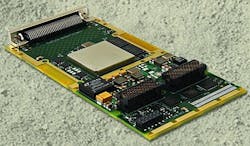I/O XMC board for avionics, radar, and digital imaging introduced by Curtiss-Wright
HIGH WYCOMBE, England, 7 Sept. 2012. Curtiss-Wright Controls Defense Solutions in High Wycombe, England, is introducing the XF07-523 digital I/O Express Mezzanine Card (XMC) based on the Xilinx Kintex-7 field-programmable gate array (FPGA) for high-end defense and aerospace applications.
The open-standards-based small-form-factor XMC module (VITA 42) is designed for military embedded systems that require high-speed FPGA-based digital I/O such as avionics, radar, digital imaging, and FPGA co-processor and other test equipment.
The XF07-523 embedded computing module provides FPGA-driven LVDS I/O through the front panel and PMC/XMC connectors for rear I/O on a ruggedized XMC module designed to perform optimally in harsh operating conditions. The conduction-cooled version operates in temperatures as hot as 85 degrees Celsius.
Especially well-suited for radar and image processing applications, the XF07-523 delivers three times the performance available from earlier generation digital I/O cards while essentially keeping power dissipation the same, Curtiss-Wright officials say.
The XF07 family establishes a new common core FPGA processing block and strictly defined PCB territory that enables fast, simple modification and upgrading for memory and I/O interfaces with minimal effort.
The Kintex-7 FPGAs offer high-density logic, high-performance serial connectivity, memory, and digital signal processing (DSP) capabilities. Fabricated on a high-performance, low-power 28-nanometer process, all Xilinx 7 series FPGAs share a scalable optimized architecture that enables design migration across the families.
For more information contact Curtiss-Wright Defense Solutions online at www.cwcdefense.com.
Follow Military & Aerospace Electronics and Avionics Intelligence news updates on Twitter

